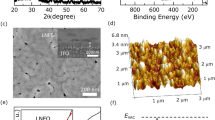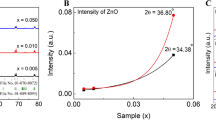Abstract
In this work, we have reported the temperature-dependent resistive switching (RS) behavior observed in (1-x)CuI.(x)La\(_{0.7}\)Sr\(_{0.3}\)MnO\(_{3}\) nanocomposites with 0.001 < x < 0.05 within the temperature range of 150 K to 300 K. Here, we observed bipolar and interface-type RS behavior, where the resistance can be altered to its previous state by the application of an opposite bias voltage. The extensive analysis of the current versus voltage data for different compositions at room temperature revealed that the dominating transport mechanisms in the low and high bias regions, respectively, were Schottky emission and Poole–Frenkel effect. The enhanced switching response of the RS medium after the addition of La\(_{0.7}\)Sr\(_{0.3}\)MnO\(_{3}\) can be attributed to the oxygen vacancy-induced conduction which was confirmed by X Ray Photoelectron Spectroscopy (XPS) measurements. In the endurance test, the highest ON/OFF ratio averaged over 100 cycles was observed to be 4.2 ± 1.1 and 3.8 ± 0.3 for x = 0.001 and 0.02 respectively at T = 300K. At T = 250 K, we obtained the optimal ON/OFF ratio of 19.8 \(\pm\) 1.8 for x = 0.001 and 22.7 \(\pm\) 4.1 for x = 0.02. The investigation of current versus voltage graphs for T = 250 K, 200 K, and 150 K further confirmed Schottky emission and the Poole–Frenkel effect as the dominating transport mechanisms at lower temperatures.






Similar content being viewed by others
References
R. Waser, R. Dittmann, S. Menzel, T. Noll, Introduction to new memory paradigms: memristive phenomena and neuromorphic applications. Faraday Discuss. 213, 11 (2019). https://doi.org/10.1039/c8fd90058b
D.S. Jeong, C.S. Hwang, Nonvolatile memory materials for neuromorphic intelligent machines. Adv. Mater. 30, 1704729 (2018). https://doi.org/10.1002/adma.201704729
R. Bez, A. Pirovano, Overview of non-volatile memory technology: markets, technologies and trends, in booktitle Advances in Non-volatile Memory and Storage Technology ( publisher Elsevier, 2014) pp. 1–24 https://doi.org/10.1533/9780857098092.1
G.W. Burr, R.M. Shelby, A. Sebastian, S. Kim, S. Kim, S. Sidler, K. Virwani, M. Ishii, P. Narayanan, A. Fumarola, L.L. Sanches, I. Boybat, M.L. Gallo, K. Moon, J. Woo, H. Hwang, Y. Leblebici, Neuromorphic computing using non-volatile memory. Adv. Phys. X 2, 89 (2016). https://doi.org/10.1080/23746149.2016.1259585
L. Peng, Z. Li, G. Wang, J. Zhou, R. Mazzarello, Z. Sun, Reduction in thermal conductivity of sb2te phase-change material by scandium/yttrium doping. J. Alloy. Compd. 821, 153499 (2020). https://doi.org/10.1016/j.jallcom.2019.153499
Q. Wang, G. Niu, R. Wang, R. Luo, Z.-G. Ye, J. Bi, X. Li, Z. Song, W. Ren, S. Song, Reliable ge2sb2te5 based phase-change electronic synapses using carbon doping and programmed pulses. J. Materiomics (2021). https://doi.org/10.1016/j.jmat.2021.08.004
A.D. Kent, D.C. Worledge, A new spin on magnetic memories. Nat. Nanotechnol. 10, 187 (2015). https://doi.org/10.1038/nnano.2015.24
T. Kawahara, K. Ito, R. Takemura, H. Ohno, Spin-transfer torque RAM technology: review and prospect. Microelectron. Reliab. 52, 613 (2012). https://doi.org/10.1016/j.microrel.2011.09.028
H. Shen, J. Liu, K. Chang, L. Fu, In-plane ferroelectric tunnel junction. Phys. Rev. Appl. 11, 024048 (2019). https://doi.org/10.1103/physrevapplied.11.024048
K. Kumari, A. Kumar, A.D. Thakur, S. Ray, Charge transport and resistive switching in a 2d hybrid interface. Mater. Res. Bull. 139, 111195 (2021). https://doi.org/10.1016/j.materresbull.2020.111195
P.M. Chowdhury, A. Raychaudhuri, Electromigration of oxygen and resistive state transitions in sub-micron width long strip of la0.85sr0.15mno3 connected to an engineered oxygen source. Mater. Res. Bull. 137, 111160 (2021). https://doi.org/10.1016/j.materresbull.2020.111160
J. Jia, J. Gao, Y. He, G. Zhao, Y. Ren, Resistive switching effect of YBa2cu3o7–x/nb:SrTiO3 heterostructure. Mater. Res. Bull. 107, 328 (2018). https://doi.org/10.1016/j.materresbull.2018.08.005
C.-A. Lin, C.-J. Huang, T.-Y. Tseng, Impact of barrier layer on HfO2-based conductive bridge random access memory. Appl. Phys. Lett. 114, 093105 (2019). https://doi.org/10.1063/1.5087421
K. Hong, K.K. Min, M.-H. Kim, S. Bang, T.-H. Kim, D.K. Lee, Y.J. Choi, C.S. Kim, J.Y. Lee, S. Kim, S. Cho, B.-G. Park, Investigation of the thermal recovery from reset breakdown of a SiN x -based RRAM. IEEE Trans. Electron Devices 67, 1600 (2020). https://doi.org/10.1109/ted.2020.2976106
K.-M. Persson, M.S. Ram, O.-P. Kilpi, M. Borg, L.-E. Wernersson, Cross-point arrays with low-power ITO-HfO 2 resistive memory cells integrated on vertical III–v nanowires. Adv. Electron. Mater. 6, 2000154 (2020). https://doi.org/10.1002/aelm.202000154
B. Sánta, D. Molnár, P. Haiber, A. Gubicza, E. Szilágyi, Z. Zolnai, A. Halbritter, M. Csontos, Nanosecond resistive switching in ag/AgI/PtIr nanojunctions. Beilstein J. Nanotechnol. 11, 92 (2020). https://doi.org/10.3762/bjnano.11.9
G. Zisis, C.Y.J. Ying, P. Ganguly, C.L. Sones, E. Soergel, R.W. Eason, S. Mailis, Enhanced electro-optic response in domain-engineered LiNbO3 channel waveguides. Appl. Phys. Lett. 109, 021101 (2016). https://doi.org/10.1063/1.4958685
X. Ding, Y. Feng, P. Huang, L. Liu, J. Kang, Low-power resistive switching characteristic in HfO2/TiOx bi-layer resistive random-access memory. Nanoscale Res. Lett. (2019). https://doi.org/10.1186/s11671-019-2956-4
D.-H. Kwon, S. Lee, C.S. Kang, Y.S. Choi, S.J. Kang, H.L. Cho, W. Sohn, J. Jo, S.-Y. Lee, K.H. Oh, T.W. Noh, R.A.D. Souza, M. Martin, M. Kim, Unraveling the origin and mechanism of nanofilament formation in polycrystalline SrTiO 3 resistive switching memories. Adv. Mater. 31, 1901322 (2019). https://doi.org/10.1002/adma.201901322
Y.B. Lin, Z.B. Yan, X.B. Lu, Z.X. Lu, M. Zeng, Y. Chen, X.S. Gao, J.G. Wan, J.Y. Dai, J.-M. Liu, Temperature-dependent and polarization-tuned resistive switching in au/BiFeO3/SrRuO3 junctions. Appl. Phys. Lett. 104, 143503 (2014). https://doi.org/10.1063/1.4870813
C. Mahata, C. Lee, Y. An, M.-H. Kim, S. Bang, C.S. Kim, J.-H. Ryu, S. Kim, H. Kim, B.-G. Park, Resistive switching and synaptic behaviors of an HfO2/al2o3 stack on ITO for neuromorphic systems. J. Alloy. Compd. 826, 154434 (2020). https://doi.org/10.1016/j.jallcom.2020.154434
H. Zhang, S. Yoo, S. Menzel, C. Funck, F. Cüppers, D.J. Wouters, C.S. Hwang, R. Waser, S. Hoffmann-Eifert, Understanding the coexistence of two bipolar resistive switching modes with opposite polarity in pt/TiO2/ti/pt nanosized ReRAM devices. ACS Appl. Mater. Interfaces 10, 29766 (2018). https://doi.org/10.1021/acsami.8b09068
N. Raeis-Hosseini, J.-S. Lee, Resistive switching memory using biomaterials. J. Electroceramics 39, 223 (2017). https://doi.org/10.1007/s10832-017-0104-z
S. Gao, X. Yi, J. Shang, G. Liu, R.-W. Li, Organic and hybrid resistive switching materials and devices. Chem. Soc. Rev. 48, 1531 (2019). https://doi.org/10.1039/c8cs00614h
A. Noohul, S. Majumder, S. Jyoti Ray, A wide bandgap semiconducting magnesium hydrogel: moisture harvest, iodine sequestration, and resistive switching. Langmuir 38(34), 10601–10610 (2022)
D. Chaudhary, S. Munjal, N. Khare, V.D. Vankar, Bipolar resistive switching and nonvolatile memory effect in poly (3-hexylthiophene) -carbon nanotube composite films. Carbon 130, 553 (2018). https://doi.org/10.1016/j.carbon.2018.01.058
S. Majumder, K. Kumari, S.J. Ray, Pulsed voltage induced resistive switching behavior of copper iodide and la0.7sr0.3mno3 nanocomposites. Mater. Lett. 302, 130339 (2021). https://doi.org/10.1016/j.matlet.2021.130339
E. Ercan, J.-Y. Chen, P.-C. Tsai, J.-Y. Lam, S.C.-W. Huang, C.-C. Chueh, W.-C. Chen, A redox-based resistive switching memory device consisting of organic-inorganic hybrid perovskite/polymer composite thin film. Adv. Electron. Mater. 3, 1700344 (2017). https://doi.org/10.1002/aelm.201700344
K. Karuna, S.J. Ray, A.D. Thakur, Resistive switching phenomena: a probe for the tracing of secondary phase in manganite. Appl. Phys. A 128(5), 1–11 (2022)
K. Karuna, A.D. Thakur, S.J. Ray, Structural, resistive switching and charge transport behaviour of (1-x) La 0.7 Sr 0.3 MnO 3.(x) ZnO composite system. Appl. Phys. A 128(11), 992 (2022)
K. Karuna, A.D. Thakur, S.J. Ray, The effect of graphene and reduced graphene oxide on the resistive switching behavior of La0. 7Ba0. 3MnO3. Mater. Today Commun. 26, 102040 (2021)
K. Karuna, S. Kar, A.D. Thakur, S.J. Ray, Role of an oxide interface in a resistive switch. Curr. Appl. Phys. 35, 16–23 (2022)
K. Karuna, S. Majumder, A.D. Thakur, S.J. Ray, Temperature-dependent resistive switching behaviour of an oxide memristor. Mater. Lett. 303, 130451 (2021)
K. Ashutosh, K. Kumari, S.J. Ray, A.D. Thakur, Graphene mediated resistive switching and thermoelectric behavior in lanthanum cobaltate. J. Appl. Phys. 127(23), 235103 (2020)
V.K. Perla, S.K. Ghosh, K. Mallick, Light induced transformation of resistive switching polarity in sb2s3 based organic-inorganic hybrid devices. J. Mater. Chem. C (2021). https://doi.org/10.1039/d1tc01121a
W. Yu, F. Chen, Y. Wang, L. Zhao, Rapid evaluation of oxygen vacancies-enhanced photogeneration of the superoxide radical in nano-TiO\(_{2}\) suspensions. RSC Adv. 10, 29082 (2020). https://doi.org/10.1039/d0ra06299e
D. Chen, Y. Wang, Z. Lin, J. Huang, X. Chen, D. Pan, F. Huang, Growth strategy and physical properties of the high mobility p-type CuI crystal. Crystal Growth Design 10, 2057 (2010). https://doi.org/10.1021/cg100270d
J. Dhanalakshmi, S. Iyyapushpam, S.T. Nishanthi, M. Malligavathy, D.P. Padiyan, Investigation of oxygen vacancies in ce coupled TiO\(_{2}\) nanocomposites by Raman and PL spectra. Adv. Nat. Sci. Nanosci. Nanotechnol. 8, 015015 (2017). https://doi.org/10.1088/2043-6254/aa5984
S. Choudhary, M. Soni, S.K. Sharma, Low voltage controlled switching of MoStextsubscript2 -GO resistive layers based ReRAM for non-volatile memory applications. Semicond. Sci. Technol. 34, 085009 (2019). https://doi.org/10.1088/1361-6641/ab2c09
G. Khurana, P. Misra, N. Kumar, R.S. Katiyar, Tunable power switching in nonvolatile flexible memory devices based on graphene oxide embedded with ZnO nanorods. J. Phys. Chem. C 118, 21357 (2014). https://doi.org/10.1021/jp506856f
L. Cao, O. Petracic, P. Zakalek, A. Weber, U. Rücker, J. Schubert, A. Koutsioubas, S. Mattauch, T. Brückel, Reversible control of physical properties via an oxygen-vacancy-driven topotactic transition in epitaxial la0.7 sr0.3 MnO3-\(\delta\) thin films. Adv. Mater. 31, 1806183 (2018). https://doi.org/10.1002/adma.201806183
L. Yao, S. Inkinen, S. van Dijken, Direct observation of oxygen vacancy-driven structural and resistive phase transitions in la2/3sr1/3mno3. Nat. Commun. (2017). https://doi.org/10.1038/ncomms14544
P. Sirimanne, M. Rusop, T. Shirata, T. Soga, T. Jimbo, Characterization of transparent conducting CuI thin films prepared by pulse laser deposition technique. Chem. Phys. Lett. 366, 485 (2002). https://doi.org/10.1016/s0009-2614(02)01590-7
N.P. Klochko, K.S. Klepikova, V.R. Kopach, D.O. Zhadan, V.V. Starikov, D.S. Sofronov, I.V. Khrypunova, S.I. Petrushenko, S.V. Dukarov, V.M. Lyubov, M.V. Kirichenko, S.P. Bigas, A.L. Khrypunova, Solution-produced copper iodide thin films for photosensor and for vertical thermoelectric nanogenerator, which uses a spontaneous temperature gradient. J. Mater. Sci.: Mater. Electron. 30, 17514 (2019). https://doi.org/10.1007/s10854-019-02103-4
J.-H. Park, E. Vescovo, H.-J. Kim, C. Kwon, R. Ramesh, T. Venkatesan, Magnetic properties at surface boundary of a half-metallic FerromagnetLa0.7sr0.3mno3. Phys. Rev. Lett. 81, 1953 (1998). https://doi.org/10.1103/physrevlett.81.1953
N. Kallel, S. Kallel, A. Hagaza, M. Oumezzine, Magnetocaloric properties in the cr-doped la0.7sr0.3mno3 manganites. Physica B 404, 285 (2009). https://doi.org/10.1016/j.physb.2008.10.049
K. Kumari, A. Kumar, D.K. Kotnees, J. Balakrishnan, A.D. Thakur, S. Ray, Structural and resistive switching behaviour in lanthanum strontium manganite—reduced graphene oxide nanocomposite system. J. Alloy. Compd. 815, 152213 (2020). https://doi.org/10.1016/j.jallcom.2019.152213
X. Zhang, X. Kan, M. Wang, R. Rao, N. Qian, G. Zheng, Y. Ma, Mechanism of enhanced magnetization in CoFe2o4/la0.7sr0.3mno3 composites with different mass ratios. Ceram. Int. 46, 14847 (2020). https://doi.org/10.1016/j.ceramint.2020.03.010
E. Beyreuther, S. Grafström, L.M. Eng, C. Thiele, K. Dörr, XPS investigation of mn valence in lanthanum manganite thin films under variation of oxygen content. Phys. Rev. B 73, 155425 (2006). https://doi.org/10.1103/physrevb.73.155425
R. Das, T. Sarkar, K. Mandal, Multiferroic properties of ba2+and gd3+co-doped bismuth ferrite: magnetic, ferroelectric and impedance spectroscopic analysis. J. Phys. D Appl. Phys. 45, 455002 (2012). https://doi.org/10.1088/0022-3727/45/45/455002
M.T. Greiner, L. Chai, M.G. Helander, W.-M. Tang, Z.-H. Lu, Transition metal oxide work functions: the influence of cation oxidation state and oxygen vacancies. Adv. Func. Mater. 22, 4557 (2012). https://doi.org/10.1002/adfm.201200615
S. Majumder, et al., For Additional Results on Temperature-dependent resistive switching behavior of a hybrid semiconductor-oxide planar system. https://doi.org/10.1007/s00339-023-06616-y
K. Komal, G. Gupta, M. Singh, B. Singh, Improved resistive switching of RGO and SnO2 based resistive memory device for non-volatile memory application. J. Alloy. Compd. 923, 166196 (2022). https://doi.org/10.1016/j.jallcom.2022.166196
S.J. Hibble, S.P. Cooper, A.C. Hannon, I.D. Fawcett, M. Greenblatt, Local distortions in the colossal magnetoresistive manganates la0.70ca0.30mno3, la0.80ca0.20mno3and la0.70sr0.30mno3revealed by total neutron diffraction. J. Phys.: Condens. Matter 11, 9221 (1999). https://doi.org/10.1088/0953-8984/11/47/308
R.W.G. Wyckoff, E. Posnjak, The crystal structures of the cuprous halides. J. Am. Chem. Soc. (1922). https://doi.org/10.1021/ja01422a005
Acknowledgements
This work was financially supported by the Department of Science and Technology, India through the INSPIRE scheme (Ref: DST/INSPIRE/04/2015/003087), ECR Grant (Ref: ECR/2017/002223) and CRG Grant (Ref: CRG/2019/003289). SJR sincerely acknowledges the support provided by UGC-DAE Consortium for Scientific Research (Ref: CSR-IC-263, CRS-M-321) and Indian Institute of Technology Patna. Shantanu Majumder acknowledges the financial support from UGC, India, through UGC-NET Scholarship.
Author information
Authors and Affiliations
Corresponding author
Additional information
Publisher’s Note
Springer Nature remains neutral with regard to jurisdictional claims in published maps and institutional affiliations.
Rights and permissions
Springer Nature or its licensor (e.g. a society or other partner) holds exclusive rights to this article under a publishing agreement with the author(s) or other rightsholder(s); author self-archiving of the accepted manuscript version of this article is solely governed by the terms of such publishing agreement and applicable law.
About this article
Cite this article
Majumder, S., Kumari, K. & Ray, S.J. Temperature-dependent resistive switching behavior of a hybrid semiconductor-oxide planar system. Appl. Phys. A 129, 357 (2023). https://doi.org/10.1007/s00339-023-06616-y
Received:
Accepted:
Published:
DOI: https://doi.org/10.1007/s00339-023-06616-y




